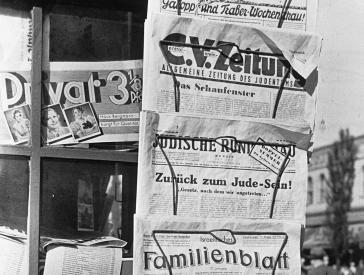No Compromises! The Art of Boris Lurie
Press Information
Press Release, Thu 25 Feb 2016
Duration: 26 February to 31 July 2016
The Jewish Museum Berlin has opened the largest retrospective yet of the artist Boris Lurie, a member of the NO!art movement, including works never before shown. With the exhibition, the museum is inviting visitors to discover the uncompromising artist and his very timely body of work. Denouncing racism, sexism and consumer culture, he produced works that are at once horrifying and fascinating. The exhibition, spread across thirteen sections and a media room, spans the oeuvre of Lurie, who died in 2008 at the age of 83. More than 200 collages, drawings, paintings, assemblages and sculptures from every period of his career will be shown in over 650 square meters of gallery space.
- Kontakt
-
Press office
T +49 (0)30 259 93 419
presse@jmberlin.de
- Address
Jewish Museum Berlin Foundation
Lindenstraße 9–14
10969 Berlin
"Like almost no one else, Boris Lurie sought to grapple radically through art with the Holocaust and the twentieth century", says Cilly Kugelmann, Program Director at the Jewish Museum Berlin. "His work hasn’t lost any of its provocative power and aesthetic radicality. The destructive element that had shaped his life so mercilessly is expressed by his images and writings with great creative skill and an aggressive rage."
"I acquired the basics of my art at concentration camps like Buchenwald."
Boris Lurie was born in 1924 into a well-to-do family in Leningrad (now St. Petersburg) and grew up in Riga. Together with his father, he survived the Riga Ghetto and the Stutthof and Buchenwald concentration camps. His mother, grandmother, younger sister and the love his youth were murdered in 1941 in mass shootings in the Rumbula Forest near Riga. In 1946, Lurie emigrated to New York with his father. He responded to his experience of persecution and camp imprisonment with his 1946 cycle War Series. These drawings, works in ink, sketches and oil paintings were not meant for the public eye and were only first exhibited in 2013 in New York. Referring to his own later artwork, he once said, "I would have liked to make pretty pictures, but something always stopped me."
The NO!art Movement
In New York, Lurie was confronted by a society unscarred by experiences of wartime and the Holocaust. During the American media’s first reports of mass murder in Europe, photographs of stacked corpses were displayed alongside erotically charged advertisements. In response to this commercialized society, he co-founded the NO!art movement in 1959 with his friends and fellow artists Stanley Fisher and Sam Goodman. They protested an increasingly banal and commercial art business and saw themselves as a countermovement to popular schools of art such as Abstract Expressionism and Andy Warhol’s Pop Art. With exhibitions such as Vulgar Show, Involvement Show, and No!Show, they demanded critical engagement with current political and social themes instead of artistic fads devoid of content. The group rejected the art market and art critics and dealers, in turn, reacted dismissively. Thus Lurie positioned himself as an artistic and social outsider. After his father’s death in 1964, Boris Lurie’s inheritance included a house near Central Park, and he began trading in the stock market. As a poet and man of letters, he published the novel House of Anita and the poetry collection Geschriebigtes/Gedichtigtes (a playful German title along the lines of "Literalia/Poetralia"). The exhibit’s sections are augmented by many of his poems and quotes.
Sections of the Exhibit
The section titled Saturation Paintings exhibits the disturbing collages in which Lurie juxtaposes historical Holocaust photos against pin-up images from American magazines. In them he pairs his disgust for a humanity capable of displacing and murdering millions en masse with pornographic pictures. He further expressed this revulsion in the large-format artworks of his abstract series Dismembered Women. After the hunger and war in Europe, these plump women’s bodies, chopped to pieces, are his reaction to the saturated American society of the 1950s and ’60s. Lurie’s obsessive occupation with the female body pervades his life’s work. In the series Altered Portraits and Adieu Amérique as well as his sculptures, he gives a reckoning of social conditions and the indifferent spinelessness of modern politicians. The large-format works in the final section, Adieu Amérique, are a coming-to-accounts with the United States, a country he spurned for decades and yet did not wish to leave. The media room, styled after his studio, features five documentary films about Boris Lurie as a person and his way of working.
Boris Lurie Art Foundation
The exhibition is a collaboration with the Boris Lurie Art Foundation in New York. Since 2009, the Boris Lurie Art Foundation has been devoted to Boris Lurie’s artistic legacy. It has made possible numerous exhibitions in the United States, Paris, Moscow and most recently Cologne’s NS Documentation Center.
The exhibition design was conceived by Holzer Kobler Architekturen (Zurich/Berlin).
The exhibition catalog No Compromises! The Art of Boris Lurie, edited by Cilly Kugelmann on behalf of the Jewish Museum Berlin, has been published by Kerber Verlag. (176 pages with 200 full-color illustrations, in German and English editions. Bookstore price: 36 €; museum price: 29 €.)
Duration: 26 February to 31 July 2016
Location: Old Building, first level
Hours: Tues–Sun: 10am–8pm; Mon: 10am–10pm
Admission: With museum ticket (8 €, 3 € discounted)
Public tours: Sundays at 2pm; Price: 3 € plus admission; reserve at +49 (30) 25993 305
Accompanying Events Program: Current information at www.jmberlin.de/lurie
Media Partners
Wall AG, monopol – Magazin für Kunst und Leben, ZITTY, Exberliner




